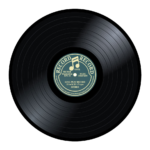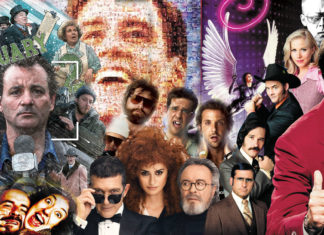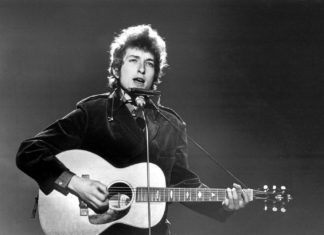 What’s the Blues?
What’s the Blues?
Blues is a genre and musical form originated by African Americans in the Deep South of the United States around the end of the 19th century. The genre developed from roots in African-American work songs and European-American folk music. Blues incorporated spirituals, work songs, field hollers, shouts, chants, and rhymed simple narrative ballads. The blues form, ubiquitous in jazz, rhythm and blues and rock and roll, is characterized by the call-and-response pattern, the blues scale and specific chord progressions, of which the twelve-bar blues is the most common. Blue notes (or “worried notes”), usually thirds or fifths flattened in pitch, are also an important part of the sound. Blues shuffles or walking bass reinforce the trance-like rhythm and form a repetitive effect known as the groove.
Buddy Guy – Five Long Years
Blues as a genre is also characterized by its lyrics, bass lines, and instrumentation. Early traditional blues verses consisted of a single line repeated four times. It was only in the first decades of the 20th century that the most common current structure became standard: the AAB pattern, consisting of a line sung over the four first bars, its repetition over the next four, and then a longer concluding line over the last bars. Early blues frequently took the form of a loose narrative, often relating the troubles experienced in African-American society.
W.C.Handy’s Orchestra – St. Louis Blues (1914)
The first publication of blues sheet music was in 1908: Antonio Maggio’s “I Got the Blues” is the first published song to use the word blues. Hart Wand’s “Dallas Blues” followed in 1912; W. C. Handy’s “The Memphis Blues” followed in the same year. The first recording by an African American singer was Mamie Smith’s 1920 rendition of Perry Bradford’s “Crazy Blues”. But the origins of the blues were some decades earlier, probably around 1890. This music is poorly documented, partly because of racial discrimination in U.S. society, including academic circles, and partly because of the low rate of literacy among rural African Americans at the time.
Otha Turner – Station Blues
Reports of blues music in southern Texas and the Deep South were written at the dawn of the 20th century. Charles Peabody mentioned the appearance of blues music at Clarksdale, Mississippi, and Gate Thomas reported similar songs in southern Texas around 1901–1902. These observations coincide more or less with the recollections of Jelly Roll Morton, who said he first heard blues music in New Orleans in 1902; Ma Rainey, who remembered first hearing the blues in the same year in Missouri; and W.C. Handy, who first heard the blues in Tutwiler, Mississippi, in 1903. The first extensive research in the field was performed by Howard W. Odum, who published an anthology of folk songs from Lafayette County, Mississippi, and Newton County, Georgia, between 1905 and 1908. The first noncommercial recordings of blues music, termed proto-blues by Paul Oliver, were made by Odum for research purposes at the very beginning of the 20th century. They are now lost.
Tommy Johnson – Canned Heat Blues (1928)
Other recordings that are still available were made in 1924 by Lawrence Gellert. Later, several recordings were made by Robert W. Gordon, who became head of the Archive of American Folk Songs of the Library of Congress. Gordon’s successor at the library was John Lomax. In the 1930s, Lomax and his son Alan made a large number of non-commercial blues recordings that testify to the huge variety of proto-blues styles, such as field hollers and ring shouts. A record of blues music as it existed before 1920 can also be found in the recordings of artists such as Lead Belly and Henry Thomas. All these sources show the existence of many different structures distinct from twelve-, eight-, or sixteen-bar.
John Lomax (left) shaking hands with musician “Uncle” Rich Brown in Sumterville, Alabama
Black Snake Moan – Blind Lemon Jefferson
As the recording industry grew, country blues performers like Bo Carter, Jimmie Rodgers (country singer), Blind Lemon Jefferson, Lonnie Johnson, Tampa Red and Blind Blake became more popular in the African American community. Kentucky-born Sylvester Weaver was in 1923 the first to record the slide guitar style, in which a guitar is fretted with a knife blade or the sawed-off neck of a bottle. The slide guitar became an important part of the Delta blues. The first blues recordings from the 1920s are categorized as a traditional, rural country blues and a more polished city or urban blues.
Bessie Smith – A Good Man is Hard to Find
After World War II, new styles of electric blues became popular in cities such as Chicago,Memphis, Detroit and St. Louis. Electric blues used electric guitars, double bass (gradually replaced by bass guitar), drums, and harmonica (or “blues harp”) played through a microphone and a PA system or an overdriven guitar amplifier. Chicago became a center for electric blues from 1948 on, when Muddy Waters recorded his first success, “I Can’t Be Satisfied.” Chicago blues is influenced to a large extent by Delta blues, because many performers had migrated from the Mississippi region.
Muddy Waters – Mannish Boy
Howlin’ Wolf, Muddy Waters, Willie Dixon and Jimmy Reed were all born in Mississippi and moved to Chicago during the Great Migration. Their style is characterized by the use of electric guitar, sometimes slide guitar, harmonica, and a rhythm section of bass and drums.The saxophonist J. T. Brown played in bands led by Elmore James and by J. B. Lenoir, but the saxophone was used as a backing instrument for rhythmic support more than as a lead instrument.
Dust My Broom – Elmore James
Little Walter, Sonny Boy Williamson (Rice Miller) and Sonny Terry are well known harmonica (called “harp” by blues musicians) players of the early Chicago blues scene. Other harp players such as Big Walter Horton were also influential. Muddy Waters and Elmore James were known for their innovative use of slide electric guitar. Howlin’ Wolf and Muddy Waters were known for their deep, “gravelly” voices.
Little Walter’s Jump – Little Walter live
The bassist and prolific songwriter and composer Willie Dixon played a major role on the Chicago blues scene. He composed and wrote many standard blues songs of the period, such as “Hoochie Coochie Man,” “I Just Want to Make Love to You” (both penned for Muddy Waters) and, “Wang Dang Doodle” and “Back Door Man” for Howlin’ Wolf. Most artists of the Chicago blues style recorded for the Chicago-based Chess Records and Checker Records labels. Smaller blues labels of this era included Vee-Jay Records and J.O.B. Records. During the early 1950s, the dominating Chicago labels were challenged by Sam Phillips’ Sun Records company in Memphis, which recorded B. B. King and Howlin’ Wolf before he moved to Chicago in 1960. After Phillips discovered Elvis Presley in 1954, the Sun label turned to the rapidly expanding white audience and started recording mostly rock ‘n’ roll.
Willie Dixon You Shook Me
In the 1950s, blues had a huge influence on mainstream American popular music. While popular musicians like Bo Diddley and Chuck Berry, both recording for Chess, were influenced by the Chicago blues, their enthusiastic playing styles departed from the melancholy aspects of blues. Chicago blues also influenced Louisiana’s zydeco music, with Clifton Chenier using blues accents. Zydeco musicians used electric solo guitar and cajun arrangements of blues standards.
In England, electric blues took root there during a much acclaimed Muddy Waters tour. Waters, unsuspecting of his audience’s tendency towards skiffle, an acoustic, softer brand of blues, turned up his amp and started to play his Chicago brand of electric blues. Although the audience was largely jolted by the performance, the performance influenced local musicians such as Alexis Korner and Cyril Davies to emulate this louder style, inspiring the British invasion of the Rolling Stones and the Yardbirds.
In the late 1950s, a new blues style emerged on Chicago’s West Side pioneered by Magic Sam, Buddy Guy and Otis Rush on Cobra Records. The “West Side sound” had strong rhythmic support from a rhythm guitar, bass guitar and drums and as perfected by Guy, Freddie King, Magic Slim and Luther Allison was dominated by amplified electric lead guitar. Expressive guitar solos were a key feature of this music.
Slim Harpo Baby, Scratch My Back
Very interesting video a specially for the Choreographies! James Brown like it !
By the late 1950s, the swamp blues genre developed near Baton Rouge, with performers such as Lightnin’ Slim, Slim Harpo, Sam Myers and Jerry McCain around the producer J. D. “Jay” Miller and the Excello label. Strongly influenced by Jimmy Reed, Swamp blues has a slower pace and a simpler use of the harmonica than the Chicago blues style performers such as Little Walter or Muddy Waters. Songs from this genre include “Scratch my Back”, “She’s Tough” and “I’m a King Bee.” Alan Lomax’s recordings of Mississippi Fred McDowell would eventually bring him wider attention on both the blues and folk circuit, with McDowell’s droning style influencing North Mississippi hill country blues musicians.
By the beginning of the 1960s, genres influenced by African American music such as rock and roll and soul were part of mainstream popular music. White performers had brought African-American music to new audiences, both within the U.S. and abroad. However, the blues wave that brought artists such as Muddy Waters to the foreground had stopped. Bluesmen such as Big Bill Broonzy and Willie Dixon started looking for new markets in Europe. Dick Waterman and the blues festivals he organized in Europe played a major role in propagating blues music abroad. In the UK, bands emulated U.S. blues legends, and UK blues rock-based bands had an influential role throughout the 1960s. Blues legend B.B. King with his guitar, “Lucille”
Big Joe Turner – Shake, Rattle & Roll
Blues performers such as John Lee Hooker and Muddy Waters continued to perform to enthusiastic audiences, inspiring new artists steeped in traditional blues, such as New York–born Taj Mahal. John Lee Hooker blended his blues style with rock elements and playing with younger white musicians, creating a musical style that can be heard on the 1971 album Endless Boogie. B. B. King’s virtuoso guitar technique earned him the eponymous title “king of the blues”. King introduced a sophisticated style of guitar soloing based on fluid string bending and shimmering vibrato that influenced many later electric blues guitarists. In contrast to the Chicago style, King’s band used strong brass support from a saxophone, trumpet, and trombone, instead of using slide guitar or harp. Tennessee-born Bobby “Blue” Bland, like B. B. King, also straddled the blues and R&B genres. During this period, Freddie King and Albert King often played with rock and soul musicians (Eric Clapton and Booker T & the MGs) and had a major influence on those styles of music.
Ray charles -Hit the road Jack
The music of the Civil Rights and Free Speech movements in the U.S. prompted a resurgence of interest in American roots music and early African American music. As well festivals such as the Newport Folk Festival brought traditional blues to a new audience, which helped to revive interest in prewar acoustic blues and performers such as Son House, Mississippi John Hurt, Skip James, and Reverend Gary Davis. Many compilations of classic prewar blues were republished by the Yazoo Records. J. B. Lenoir from the Chicago blues movement in the 1950s recorded several LPs using acoustic guitar, sometimes accompanied by Willie Dixon on the acoustic bass or drums. His songs, originally distributed only in Europe, commented on political issues such as racism or Vietnam War issues, which was unusual for this period. His album Alabama Blues contained a song with the following lyric:
Mississippi John Hurt Make Me a Pallet on the Floor
Excellent !
In the early 1970s, The Texas rock-blues style emerged, which used guitars in both solo and rhythm roles. In contrast with the West Side blues, the Texas style is strongly influenced by the British rock-blues movement. Major artists of the Texas style are Johnny Winter, Stevie Ray Vaughan, the Fabulous Thunderbirds (led by harmonica player and singer-songwriter Kim Wilson), and ZZ Top. These artists all began their musical careers in the 1970s but they did not achieve international success until the next decade.
Since the 1980s there has been a resurgence of interest in the blues among a certain part of the African-American population, particularly around Jackson, Mississippi and other deep South regions. Often termed “soul blues” or “Southern soul”, the music at the heart of this movement was given new life by the unexpected success of two particular recordings on the Jackson-based Malaco label: Z. Z. Hill’s Down Home Blues (1982) and Little Milton’s The Blues is Alright (1984). Contemporary African-American performers who work in this style of the blues include Bobby Rush, Denise LaSalle, Sir Charles Jones, Bettye LaVette, Marvin Sease, Peggy Scott-Adams, Mel Waiters, Clarence Carter, Dr. “Feelgood” Potts, O.B. Buchana, Ms. Jody, Shirley Brown, and dozens of others.
Stevie Ray Vaughan – Riviera Paradise/Lenny – Tokyo 1985
During the 1980s blues also continued in both traditional and new forms. In 1986 the album Strong Persuader announced Robert Cray as a major blues artist. The first Stevie Ray Vaughan recording Texas Flood was released in 1983, and the Texas-based guitarist exploded onto the international stage. John Lee Hooker’s popularity was revived with the album The Healer in 1989. Eric Clapton, known for his performances with the Blues Breakers and Cream, made a comeback in the 1990s with his album Unplugged, in which he played some standard blues numbers on acoustic guitar.
Eric Clapton – Rollin’ & Tumblin (Unplugged)
However, beginning in the 1990s, digital multitrack recording and other technological advances and new marketing strategies including video clip production increased costs, challenging the spontaneity and improvisation that are an important component of blues music. In the 1980s and 1990s, blues publications such as Living Blues and Blues Revue were launched, major cities began forming blues societies, outdoor blues festivals became more common, and more nightclubs and venues for blues emerged.
In the 1990s, the largely ignored hill country blues gained minor recognition in both blues and alternative rock music circles with northern Mississippi artists R. L. Burnside and Junior Kimbrough.Blues performers explored a range of musical genres, as can be seen, for example, from the broad array of nominees of the yearly Blues Music Awards, previously named W. C. Handy Awards or of the Grammy Awards for Best Contemporary and Traditional Blues Album. The Billboard Blues Album chart provides an overview of current blues hits. Contemporary blues music is nurtured by several blues labels such as: Alligator Records, Ruf Records, Severn Records, Chess Records (MCA), Delmark Records, NorthernBlues Music, Fat Possum Records and Vanguard Records (Artemis Records). Some labels are famous for rediscovering and remastering blues rarities, including Arhoolie Records, Smithsonian Folkways Recordings (heir of Folkways Records), and Yazoo Records (Shanachie Records).
Ali Farka Touré & Ry Cooder – Talking Timbuktu
In the 2000s blues rock gained a cultural following, especially as after the rise of the Internet, when artists started creating YouTube channels, forums, and Facebook pages. Notable blues rock musicians of this period include Joe Bonamassa, Gary Clark Jr., Shemekia Copeland, Eric Gales, Beth Hart, Warren Haynes, Jason Ricci, Susan Tedeschi, Derek Trucks, Ben Harper (in collaboration with Charlie Musselwhite) and Orianthi. Alternative rock artists still combine strong elements of blues in their music, especially ZZ Ward, Cage the Elephant, Jack White, and the Black Keys.
The Black Keys – Lonely Boy
Listen too : Blues Funk
Source : wikipedia


























